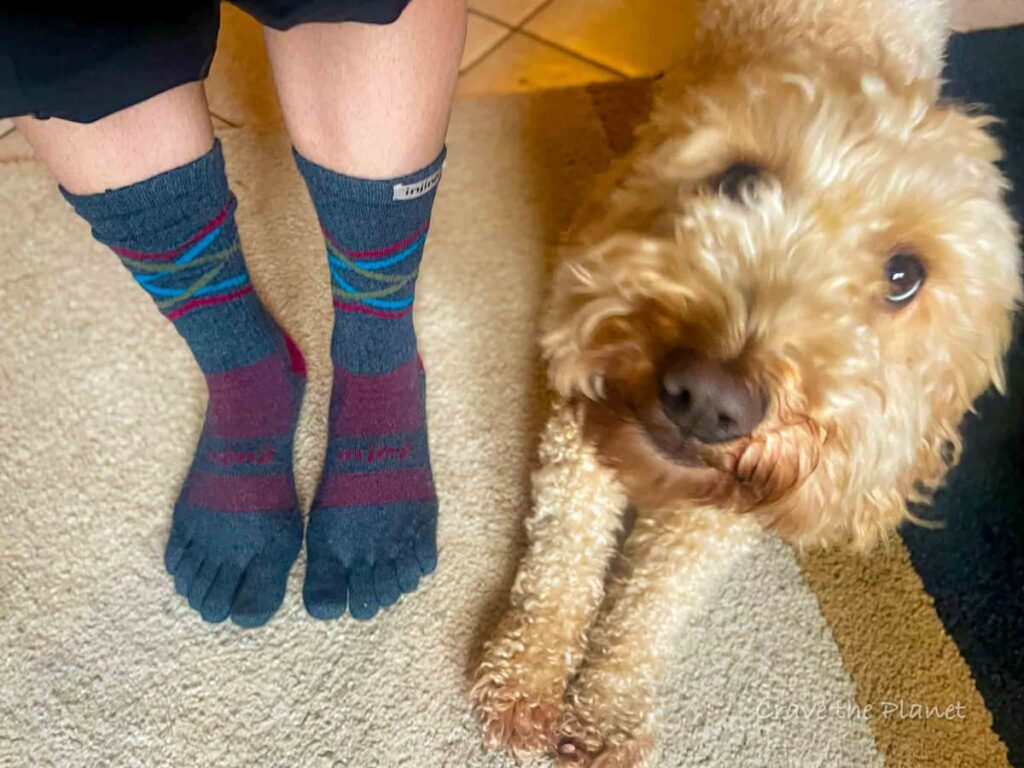Toe socks are said to prevent blisters, but are they really worth the hype? Let me share my knowledge based on 17 years practice as a physical therapist and lifelong hiker.
Physical Therapist Tips to Prevent Blisters Before They Start

What You Will Learn
Do Toe Socks Prevent Blisters?
Yes and No. Let’s face it, there’s no one size fits all solution to blisters. As someone who has tried hiking with toe socks, it’s clear that they do offer some benefits over regular socks. However, in my opinion, they may be over-hyped.
| TL;DR From Author
Slip into the silky softness of the Injinji Toe Socks. Move safely among wonders, with gear so comfortable that you can experience blister-free adventures.
Are Toe Socks for Hiking Worth it?
Toe socks are not for everyone. But they are good for 👎🏻
- 🥾 Mountaineers, Trekkers, Hikers really prone to skin breakdown (blisters)
- 🔥 Hikers in hot weather
- 🌏 People that sock liners don’t work
- Birkenstock “Hikers”
🧭 Read until the end for my insider travel tips from a physical therapist hiking & travel addict.
You will also like:
🗻 Stay in touch with your group with the best 2 way radios for the mountains.
🧥 Take a look at the best hiking jackets for women.
Tips
- Toe socks can prevent blisters, but they may not be as effective as some hikers claim.
- When choosing hiking socks, consider factors such as fit, material, and moisture-wicking abilities.
- Sock liners can also be an effective way to prevent blisters while hiking.
Why Toe Socks Prevent Blisters
When it comes to preventing blisters, toe socks are a great option. They are especially effective at preventing blisters between your toes. While there are no studies to support this claim, many hikers and runners swear by the benefits of toe socks.
One of the main reasons toe socks are effective at preventing blisters is because they eliminate the friction that occurs between your toes when wearing regular socks. In regular socks, your toes are cramped up and slightly rub against each other.
With toe socks, this doesn’t happen because all of your toes are snugly wrapped in fabric. So any friction happens between the fabric, not your skin.
This can be especially helpful for preventing toe blisters caused by rubbing and chafing. By keeping your toes in place and preventing them from rubbing against each other, toe socks can help prevent blisters from forming.
However, it’s important to note that toe socks are not a perfect solution. They can feel weird to wear at first and take some getting used to.
They can also be harder to put on, especially when your feet are damp.
Tip: you need shoes with a wide enough toebox to accommodate the extra fabric of the toe socks.
It’s also important to find high-quality toe socks made from durable materials like merino wool. Toe socks tend to develop holes in the toes quicker than regular socks, so finding a pair that will last is key.
Toe socks are not the “holy grail” of blister prevention, but they can be a helpful tool in preventing blisters between your toes.
However, it’s important to remember that there are other factors that are far more important in blister prevention, and blisters can form in other areas besides between the toes.
Quick Verdict – Best Toe Socks for Preventing Blisters
If you are looking for a way to prevent blisters while hiking or running, toe socks may be a great option for you. Toe socks are designed to separate your toes, reducing the friction that can lead to blisters.
After researching and analyzing various options, we have determined that Injinji toe socks are the best choice for preventing blisters.
- Injinji's five-toe patented designed specifically for runners and hikers
- Prevents blisters & hotspots while running
- Ideal use for running, walking and athletic activities
- Superior mositure management during runs of all lengths
- Natural Toe Splay
Injinji offers a variety of options for different activities, including hiking, running, and everyday wear.
Their socks are made with moisture-wicking materials and are designed to fit snugly without being too tight.
Alternatives
Other options for preventing blisters include wearing two layers of socks, using double-layer socks, or wearing socks with light cushioning.
Double-layer socks work by wicking moisture from the inner layer to the outer layer, reducing friction and preventing blisters. Light cushioning can provide additional comfort and protection without adding too much bulk.
Ultimately, the best way to prevent blisters is to find a sock that fits well and is made with moisture-wicking materials. Injinji toe socks are a great option for achieving this goal.
What Other Factors Are Important In Hiking Socks For Preventing Blisters
When it comes to preventing blisters while hiking, choosing the right socks is crucial. In addition to the factors mentioned earlier, there are other important factors to consider when selecting hiking socks.
Here are some additional factors to keep in mind:
- Fit is key. A good fit is crucial to preventing blisters. Your socks should fit snugly but not be too tight. If your socks are too loose, they can bunch up and cause friction, leading to blisters. If they’re too tight, they can restrict blood flow and cause your feet to feel cold. When trying on hiking socks, be sure to walk around in them to ensure they fit correctly.
- Material matters. In addition to merino wool, there are other materials that are good for hiking socks. Look for socks made from synthetic materials like Coolmax or polypropylene, which wick away moisture and help keep your feet dry. Avoid cotton socks, as they tend to trap moisture and can lead to blisters.
- Padding is important. Look for socks that have extra padding in areas that are prone to blisters, such as the toes and heels. Some socks even have double-layer construction to provide additional cushioning.
- Seamless socks are best. Socks with seams can cause friction and lead to blisters. Look for socks that are seamless or have flat seams to minimize rubbing.
- Consider the toe box. Socks with a wide toe box can help prevent blisters by reducing pressure on your toes. Look for socks that are designed specifically for hiking or running, as they often have a wider toe box.
- Breathability is key. Look for socks that are breathable and allow air to circulate around your feet. This will help keep your feet cool and dry, which is essential for preventing blisters.
- Choose socks that match your activity level. If you’re going on a long hike, choose socks that are designed for hiking and provide extra cushioning and support. If you’re going for a short walk, thinner socks may be more appropriate.
- Consider the weather. In addition to matching your activity level, choose socks that are appropriate for the weather conditions. Thicker socks are better for colder weather, while thinner socks are better for warmer weather.
- Change your socks frequently. If your feet tend to sweat a lot, bring extra socks and change them frequently to keep your feet dry. This can help prevent blisters from forming.
I hope these tips help you hike pain-free.
Blisters can make hiking uncomfortable and lead to sore calves and even plantar fasciitis from compensation, but they don’t have to ruin the fun.
Sock Liners Also Work Perfectly For Preventing Blisters
Wearing two layers of socks is a great trick for preventing blisters. The first layer should be a thin liner sock made mainly from synthetic materials and should fit snugly without any play.
The liner sock should also be longer than the outer sock layer, and it should not contain any cushioning.
This allows for any friction to occur between the two sock layers, instead of between your skin and the sock, which significantly reduces blister formation.
Toe sock liners, such as the Injinji liner crew toe socks, are an excellent choice for liner socks due to their improved blister resistance.
The toe sock liner should fit your feet very snugly, and they need to fit your feet well to avoid getting blisters.
Using sock liners, especially toe sock liners, can be a great solution to preventing blisters. However, if you do get a blister, it’s important to clean the area and apply a lubricant, like petroleum jelly or talcum powder, to reduce friction.
If the blister is large or painful, consult a healthcare provider for proper medical treatment.
➡️ Discover the ultimate guide to the best toe socks for hiking – read my in-depth comparison now!
Final Verdict
- Injinji's five-toe patented designed specifically for runners and hikers
- Prevents blisters & hotspots while running
- Ideal use for running, walking and athletic activities
- Superior mositure management during runs of all lengths
- Natural Toe Splay
One thing to keep in mind is that these socks require special care. They can’t be machine washed or dried, so you’ll need to hand wash them and let them air dry. This may be inconvenient for some users, but it’s worth the effort to keep these socks in good condition.
More Socks Buying Guides

Author profile: Morgan Fielder is a Doctor of Physical Therapy and passionate hiker who believes in exploring the world on foot with good food. Follow her journey as she shares science-based hiking tips and advocates for sustainable tourism.

